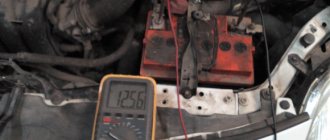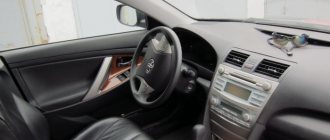Actually, I would like to talk about the car itself and a little about choosing this particular model. I was looking for a Fielder, specifically a hybrid, intact, in good configuration and with mileage in the region of 50. I used to drive both 20th and 30th Priuses - I know their big advantages and annoying disadvantages well. Fielder isn't perfect either. If, for example, the Prius is created as an independent hybrid model, which should push the boundaries of the usual, then the Fielder is simply an adaptation of an independently successful gasoline model to the needs of the public who want greater efficiency. That is, since 2012, the 160th Fielder body has been released, and in August 2013, an almost completely identical hybrid power plant from Toyota Aqua is installed in it, and we have the NKE-165 body. Which, in general, I think was not difficult, because... The 160th Fielder shares the same platform with both Aqua and Witz. Suspension parts and more fit together. Because of this, the new Fielder looks smaller from the outside than its predecessors, and also weighs less. It’s good that, thanks to competent ergonomics, the interior space was not damaged, and even grew by some crumbs compared to the 140m body. But I think what will be more interesting to many is not the comparison of the Fielder with the previous body or another model, but the difference between a hybrid and a non-hybrid one. The hybrid is noticeably heavier due to the high-voltage battery (HVB), which is located under the rear seat (by the way, there is a 12-volt battery there) and due to the inverter-converter under the hood. Although the second is in question (the battery was not easy to migrate back). By the way, the high-voltage wire from under the hood goes to the VVB directly under the bottom in an orange corrugation along the left threshold. It does not look protected from the influence of the Russian road topography due to some unfortunate combination of circumstances... Hybridity did not affect the volume of the interior and trunk in any way. On the outside, the hybrid is distinguished, in addition to the nameplates on the wings and trunk, by a different radiator grille and Toyota emblems on a blue background - like all hybrids of this brand. Hybrid Fielders exist only in front-wheel drive, and in winter the only help you have is good tires and good anti-skid (VSC + TRC), which by the way can be switched off. It works very correctly, as on the 30th Prius, allowing it to slip, but without spinning the drive wheels to the point of squealing - it simply allows them to spin, say, 10-20 km/h faster than the rear ones. By default, Hybrids also have slightly richer internal equipment, for example, they all have push-button climate control with an air ionizer and a multifunction steering wheel (full or half) and a chic on-board computer display next to the speedometer. I will definitely talk about its functionality separately and with photos another time. The hybrid is not very fast in pedal-to-the-floor acceleration and the dynamics theoretically depend on the battery charge level, because The internal combustion engine has only 74 hp. But practically the difference can only be felt if you press the gas pedal for a long time on a battery that has previously been discharged somewhere in a traffic jam, then the charge will run out and only the internal combustion engine will have thrust. If you don't play racing, you may never encounter this in the entire time. The charge is replenished quickly, both due to the internal combustion engine and due to braking (recuperation). The hybrid drives with a characteristic trolleybus sound “piiii-uuu”, and it can be heard better inside in silence than outside. The hybrid hardly wears out brake pads and discs since deceleration in most cases is due to motor generators and the pads are connected only at speeds below 7-10 km/h. By the way, this transition is not noticeable, compared to the first Priuses, when there was like a split-second gap between the recovery and the pads. Yes, I remember, this transition is felt on the Fielder, if the car has been standing in the rain for a day and the brake discs are covered with a coating of rust - then the first braking is accompanied by a noticeable dive with a slowdown when switching to the pads. And at other moments everything is smooth. On Priuses, front pads are rarely changed at mileages of up to 200 thousand km. Now the Feeder has 67 miles on it and there are no signs of wear on the discs or pads. The Hybrid Fielder has small volumes of refueling both gasoline and technical fluids - only 4 liters were spent in both cooling circuits (yes, there are two: for the internal combustion engine and the inverter), oil in the internal combustion engine 3.7 (as in a regular one), oil in the transmission - 3L (Toyota WS), tank is only 35 liters, but never fit more than 29L. While it was warm, I went to the gas station after about 700 km. The Hybrid has an electric air conditioner - you don’t need to start the engine to cool the interior. If only he had a stove from the VVB, otherwise now, with the arrival of cold weather, the internal combustion engine almost never stalls on short trips, because... The interior heating is turned on and the consumption becomes closer to summer non-hybrid. The presence of standard heated front seats is a big plus, but I’m not sure that its non-hybrid counterparts don’t have it. Most likely, the heating option is available for an additional fee to everyone. But that’s exactly what my equipment is called according to the catalogue: “Hybrid G Seat Heater”.
Toyota Corolla Fielder Hybrid
The Toyota Corolla Fielder model with a Hybrid engine combines reliability, quality and modern automotive trends.
Appearance
The station wagon is available in 9 colors, and “metallic blue” is typical for this model. The appearance of the Toyota Fielder Hybrid model is characterized by a smooth shape, elongated headlights and a large air intake. The manufacturer's logo has been slightly modified.
Interior
The budget line is characterized by a dark interior design. Expensive options boast a blue panel color. There is a huge color LCD display on the on-board console. The instrument panel is indicated by an analogue speedometer and tachometer scale.
Three-spoke leather steering wheel. The interior is spacious and can accommodate 5 passengers. The seats are comfortable and height adjustable.
Specifications
Toyota modification Fielder Hybrid is equipped with:
- 1.5 liter fuel engine with power ratings of 74 hp;
- 61 hp electric motor
The total power plant is 135 horses. A Japanese minivan consumes 3 liters per 100 km in the city, and even less on the highway. The front-wheel drive station wagon is available with automatic transmission, CVT and manual transmission.
The suspension of the Toyota Fielder modification with a hybrid engine is standard: there is a MacPherson strut in the front, a torsion beam in the rear, and the braking system has some drawbacks. Its design is a little outdated, because... There are standard brake discs at the front and drums at the rear wheels. Minivans have two types of transmission – 2VD and 4VD.
X – basic model
Equipped with climate control systems, headlight color switch. Other features include automatic braking when there is a risk of a frontal collision, downhill helper, corrections based on road markings, BAS stabilization and the ABS anti-lock system.
G – improvements to the previous version
The line is characterized by LED rear and front headlights and heated rear-view mirrors. The start and stop key works without a key. Multimedia control buttons are located on the steering wheel.
S - top trim level
It differs from previous models in the presence of sports front seats and a leather interior.
The cost of the Toyota Corolla modification Fielder hybrid starts from 15 thousand dollars for the base model. The advanced version costs over 20 thousand dollars.
Toyota Corolla 1.3, 1.4, 1.5, 1.6, 1.8 fuel consumption per 100 km. 7th, 8th, 9th, 10th, 11th generations
Japanese automaker Toyota has been producing cars since 1933. Nowadays, cars of this brand have conquered the markets of Asia, Europe, Africa, North and South America. Engineers, designers, and marketers of the concern position the models created on production lines under the mottos “reliability” and “low cost of maintenance.”
Since the mid-70s of the last century, when fuel prices began to rise rapidly, power unit designers have focused on reducing the “appetite” of engines. At the moment, the fuel consumption of Toyota cars per 100 km is one of the lowest among cars in the whole world. You can verify this by analyzing the nominal fuel consumption of the most popular models indicated by the manufacturer and comparing them with the performance of cars from other brands.
Technical characteristics of Toyota Yaris hybrid
Toyota Fielder 2008 technical specifications, equipment and prices
Subcompact and compact hatchback representative of the B-class.
The main technical characteristics are presented in the table.
| Automatic transmission | CVT |
| Wheelbase | 2510 mm |
| Clearance | 145 mm |
| Fuel tank volume | 36 l |
| Curb weight | 1,090 t |
| Front/rear wheel track | 1460 mm/1445 mm |
| EKO auto | Euro6, 75-82 g/km CO2 |
| Turning diameter | 9.6 m |
| Engine capacity | 1497 cm3 |
Gas engine
Under the hood of the Yaris Hybrid is a 1.5 liter DOHC petrol unit with 4 cylinders. Its power is 75 hp. at 4800 rpm. Maximum torque 111 Nm.
The internal combustion engine design operates on the Atkinson cycle, which helps to increase engine efficiency, reducing overall fuel consumption.
Electric motor
The Toyota Yaris Hybrid is equipped with two electric motors located under the hood:
The power of the traction electric motor is 45 kW. Maximum torque - 169 Nm.
Battery
The Toyota Yaris Hybrid is equipped with nickel-metal hydride batteries. They are located under the second row seats, along with the gas tank.
The battery has 120 cells, voltage – 144 V, cell capacity – 6.5 Ah.
A controller is installed inside the high-voltage battery (HVB) housing, which controls the charging of the battery pack and also monitors the temperature and internal resistance. It also controls the battery cooling fan.
Reference! The main principle of operation of the VVB is the conservation of excess energy from a gasoline engine and its immediate return when necessary.
Lower gears consume battery power. When braking, on the contrary, energy charges the VBB. The process of energy consumption and recovery is controlled by a computer and occurs without driver participation.
The battery can withstand up to 2000 charge/discharge cycles. On one battery charge at low speed you can travel no more than 4-5 km. The replacement cost will cost 60,000 rubles.
There is a second auxiliary battery with a voltage of 12 V. It provides backup power for on-board systems and electronics if the hybrid system and the main VVB relay are not working.
Fuel consumption per 100 km and dynamics
The dynamic characteristics of the Toyota Yaris Hybrid are as follows:
- acceleration to 100 km/h – 11.8 seconds;
- maximum speed – 165 km/h.
The fuel consumption of the hybrid hatchback is moderate. The urban cycle consumes 3.1 liters of fuel, while driving on the highway uses from 3.3 to 3.6 liters of gasoline. Fuel consumption in the combined cycle is 3.3 liters per hundred kilometers.
Technical characteristics of Toyota C-HR hybrid
Toyota c-hr hybrid: technical specifications, review
Side right view of Toyota C-HR hybrid
The updated platform required significant changes, which resulted in non-standard body dimensions and improved technical components.
The main data is presented in the table.
| Transmission type | Variable speed drive |
| Engine capacity | 1797 cm3 |
| Clearance | 140 mm |
| Wheelbase | 2640 mm |
| Turning radius | 5.2 m |
| Front/rear track width | 1540 mm/1540 mm |
| Total weight of the car | 1,715 t |
| Fuel tank volume | 43 l |
| Front/rear wheels | 225/50R18 |
Important! The characteristics do not depend on the configuration (only the internal equipment changes) and are presented only for the front-wheel drive version with an electric motor and a 1.8-liter gasoline engine.
Gas engine
Under the hood of the new C-HR is a 1.8-liter 4-cylinder petrol engine model 2ZR-FXE. Maximum power is 98 hp. at 3600 rpm. Peak torque reaches 142 Nm.
The engine has a built-in electronic fuel injection system. The whole structure is crowned by a continuously variable variator with electronic control.
Electric motor
Together with the gasoline engine, a synchronous AC electric motor also works. The electric motor is located under the hood of the car. The maximum power is 53 kW. The motor is torquey – the torque is 163 Nm, and this value is available from the start.
The car starts exclusively on electric power, and then the internal combustion engine comes into operation. Single use of the electric motor is possible. The maximum speed in this case will be limited to 100 km/h.
Battery and mileage on one charge
The nickel-metal hydride battery pack is enclosed in a special metal case and secured under the rear seats. The nominal voltage is 201.6 Volts. In this case, the VVB consists of 28 series-connected modules, the voltage of each is 7.2 Volts. On one charge the car can travel up to 2.5 km.
Display on the dashboard showing battery charge
The electrolyte in batteries is an alkaline mixture of potassium and water. It is absorbed by the battery plates and does not leak, even in a collision. VVB can withstand up to 2,000 charge/discharge cycles.
For information! The cost of replacing the battery will cost approximately 89,000 rubles.
The CH-R Hybrid crossover also contains a sealed lead-acid 12-volt auxiliary battery. It provides power to the vehicle's electrical system.
Side view
Fuel consumption per 100 km and dynamics
The maximum speed is limited to 170 km/h. Acceleration to 100 km/h takes 11 seconds, which is very good considering the characteristics of the car. In any case, while driving, you experience purely positive emotions.
When driving on the highway, about 3.5 liters of fuel are consumed. In the city, gasoline consumption increases to 4.1 liters. In the combined cycle, consumption is 3.9 liters per 100 km.
Hybrid reliability, breakdowns
The reliability of the hybrid is ensured by the updated Toyota Safety Sense system.
The advantages of the crossover: stylish design, wide functionality, improved brake discs (less subject to wear), decent power reserve, and a 5-year warranty.
The only disadvantages of the hybrid CH-R are the high cost and low ground clearance.
Among the breakdowns, it is worth noting only problems with the electronic parking brake, which provoked the appearance of an error. To correct this problem, it is necessary to replace the brake pedal limit switches.
Generation E100 Toyota Hilux
| Toyota corolla fielder 2nd restyling 2021, 2021, 2021, 2021, station wagon, 3rd generation, e160 technical specifications and equipment In some cases, tuning allows you to further optimize fuel consumption, but this is usually achieved by making the body structure lighter or by replacing the engine. For 1.5 years, the plant supplied cars with a robotic gearbox, a standard mechanical unit with clutch drives and switching drives using electronically controlled electromagnets. |
| 1NZ-FE - Toyota Corolla engine 1.5 liters | The engine characteristics are adjusted solely to ensure Euro-4 regulations and the current legislation of the countries to which Toyota cars are planned to be exported. , for one I bought 2 cans of 520 ml carb cleaner from Kerry Russia, they make it, 170 rubles per can went to the service center, measured the compression in the cylinders, it was 12 and above in all cylinders. |
- Vladimir, Taganrog. It's a nice car, I'll give it to my wife for her birthday. I'll just dry clean the interior, repaint it, install new leather seats and new rims. She doesn’t know it yet, but I’m sure she’ll like it. We have a Corolla with a 1.8 engine and automatic transmission, in the city the consumption is 10 liters per 100 km.
- Konstantin, Tambov. I have owned the Toyota Corolla for ten years now, during which time the car has shown itself to be very good. Yes, I tried my best too - I only serviced it at the dealer, and only bought original spare parts. Now the mileage is 150 thousand, I decided to sell it. It's a shame to leave, but we have to. The Corolla has served me well and still has potential for its next owner. With a powerful 1.8 engine it consumes 11 liters per 100 km, the automatic transmission works perfectly, without any special delays. I plan to take a new Toyota Camry through trade-in.
- Anton, Ekaterinoslavl. An excellent car, suitable for family and work. I've owned the car for six months, not a single breakdown. I bought it from an official dealer, through a used car service, there is one on the Toyota website. I liked the car, with a 1.8-liter engine it consumes 10-11 liters.
- Alexey, Bryansk. A car for all occasions, it impressed me with its peppy dynamics and power reserves on the highway. Friends said that the Corolla seemed like a family car, it handled poorly and was tuned for comfort. Well, no, and I was convinced of this myself, in practice, so to speak. It's probably all about the 1.8 engine, for which Toyota engineers had to modify the handling, suspension and brakes. At least the car readily obeys the steering wheel, there is minimal roll, and the suspension is a little stiff. Gasoline consumption is 11-12 liters.
Toyota Corolla E150 • The models received new performance characteristics.
Technical characteristics of Toyota Fielder hybrid
Honda insight hybrid: characteristics, review
The developers were able to adjust the characteristics of the car to the hybrid version. The dimensions of the car have not changed.
The main technical data are presented in the table.
| Body dimensions (length/width/height) | 4.4 m/ 1.695 m/ 1.475 m |
| Clearance | 155 mm |
| Tires | 185/60R15 |
| Wheelbase | 2600 mm |
| Turning radius | 4.9 m |
| Track width (front/rear) | 1470 mm/ 1460 mm |
| Total weight | 1,445 t |
| Fuel tank volume | 36 l |
| Brakes (front/rear) | ventilated disc/drum |
| CO2 emissions | 67 g/km |
Gas engine
Under the hood of the Fielder Hybrid is a four-cylinder DOHC gasoline engine 1NZ-FXE. Volume – 1.5 liters. Maximum power reaches 74 hp. at 4800 rpm. Torque is 111 Nm.
The unit is equipped with electronic direct fuel injection. The stop/start system is responsible for the timely start or inclusion of the electric motor.
Electric motor
A 1LM synchronous AC electric motor is also paired with the gasoline engine. Power is 45 kW at 169 Nm. It is also located under the hood.
The car starts on an electric motor. You can use it as the main traction motor, but it won't last long. The “electric vehicle” mode is limited to 60 km/h, after which the internal combustion engine will automatically connect.
Battery and mileage
The car is equipped with a nickel-metal hydride battery, which contains 20 cells (6.5 Ah each). It can withstand up to 1500 full charge/discharge cycles. The function of the VBB is to power the electric motor and accumulate charge during regenerative braking.
When fully charged and following the speed limit, the car can travel no more than 1.5 km on an electric charge. The cost of replacing the VVB will be about 60,000 rubles.
The standard 12-Volt battery for powering the on-board system has a capacity of 40 Ah. The maximum starting current is 350 A. Both batteries are located behind the rear row of seats.
Fuel consumption per 100 km and dynamics
Toyota Fielder Hybrid has average dynamics. Acceleration to hundreds occurs in 11 seconds. Maximum speed – 180 km/h.
In the city, the station wagon consumes 3.9 liters of gasoline, and on the highway the consumption decreases and amounts to 3.3 liters of fuel. In the combined cycle, 2.9 liters of fuel are consumed.
To reduce fuel consumption, the following recommendations are suitable:
- Avoid sudden acceleration of the car, start driving smoothly and confidently.
- Rapid changes in speed increase fuel consumption by 20%, so it is better to choose a quiet driving mode.
- Turn off the engine when parked for more than 1 minute, as idling increases fuel consumption than when starting and driving.
- Selecting a distance when driving in heavy traffic. A sharp decrease in speed and then an increase leads to additional fuel costs.
- Choice of convenient parking. Reverse maneuvers require additional gasoline consumption.
- Slow down the vehicle using the power unit. Such braking will allow you to gradually reduce the used engine power with a decrease in fuel consumption.
Hybrid reliability, breakdowns
The Toyota Safety Sense system with expanded functionality is responsible for the reliability of the hybrid.
Left view
It included:
- ABS, EBD, ESP, TCS, HAC systems;
- descent/ascent assistant;
- obstacle recognition with emergency braking;
- road mark tracking;
- rain sensor and automatic wipers;
- Automatic door locking when driving.
Among the breakdowns, it is worth highlighting overheating and loss of power to the battery. The main cause of this problem is the high-voltage wire that runs from under the hood through the bottom directly to the VVB. Given the low ground clearance and Russian roads, its damage is just a matter of time. There are two ways out of this situation: either install protection or promptly check it for wear.










